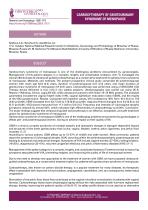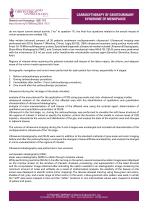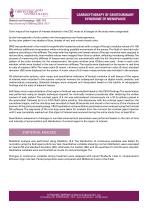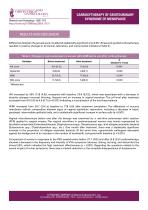 Website:
G. Trading Company
Website:
G. Trading Company
Catalog excerpts

CARBOXYTHERAPY OF GENITOURINARY SYNDROME OF MENOPAUSE AUTHOR Saidova A.S., Sencha A.N., Apolikhina I.A. 1) V.I. Kulakov National Medical Research Center for Obstetrics, Gynecology and Perinatology of Minzdrav of Russia, Moscow, Russia; 2) I.M. Sechenov First Moscow State Medical University of Minzdrav of Russia (Sechenov University), Moscow, Russia SUBJECT Genitourinary syndrome of menopause is one of the challenging problems encountered by gynecologists. Management of this patient category is a complex, lengthy and complicated endeavor. Aim. To investigate the clinical effectiveness of ultrasound-guided carboxytherapy as a conservative treatment for genitourinary syndrome of menopause. Materials and methods. The present prospective clinical study comprised 35 postmenopausal women with mean age 52.9 (3.4) years, duration of postmenopause 3.27 (2.4) years, and mean duration of genitourinary syndrome of menopause 2.9 (0.9) years. Carboxytherapy was performed using a VENUSIAN CO2 Therapy device delivered in four (3.5) 5 min weekly sessions. Ultrasonography was carried out using DC-8, Resona-7 (Mindray, China), Logiq E9 (GE, USA) ultrasound scanners with linear 7.5–15 MHz probes. The analyzed parameters included the vaginal health index (VHI), vaginal epithelium maturation index (VEMI), and the results of the VSQ questionnaire. Results. Compared with baseline values, VHI increased by 30% from 10.4 (5.2) to 17.8 (4.9) (p<0.001); VEMI increased from 53.7 (3.9) to 77.8 (9.9) (p<0.001). Vaginal pH level changed from 6.0 (0.9) to 4.6 (0.7) (p<0.001). VSQ scores improved from 11.7 (4.8) to 5.9 (2.5). Frequency and intensity of vulvovaginal atrophy symptoms reduced by almost 50%, which indicates high effectiveness of carboxytherapy (p<0.001). Conclusion. The study findings suggest that ultrasound-guided carboxytherapy is an effective, acceptable, and safe treatment option for genitourinary syndrome of menopause. Genitourinary syndrome of menopause (GSM) is one of the challenging problems encountered by gynecologists. It affects peri- and postmenopausal women, having an adverse impact on their quality of life. GSM is a chronic complex syndrome of multiple atrophic and dystrophic changes in estrogen-dependent tissues and structures of the lower genitourinary tract (vulva, vagina, bladder, urethra, pelvic ligaments, and pelvic floor muscles) [1, 2]. According to various authors, GSM affects up to 15–57% of midlife and older women. Most commonly, patients report the symptoms of vulvovaginal atrophy (VVA) occurring within the perimenopause/early postmenopause and leading to functional and anatomical changes. Symptoms of VVA include vaginal dryness (27–50%), itching/irritation, (18-25%), dyspareunia (33–41%), recurrent urogenital infectious and pelvic inflammatory diseases (6-8%) [1–7]. Management of this patient category is a complex, lengthy, and complicated endeavor.Treatment aimed at improving symptoms associated with VVA, preventing relapses, and improving the quality of life of menopausal women. Due to the need to develop new approaches to the treatment of women with GSM, we have proposed ultrasoundguided carboxytherapy as a conservative treatment option for patients with genitourinary syndrome of menopause. Carboxytherapy, also known as carbon dioxide therapy, is a popular treatment for many diseases. Its therapeutic effect is associated with improved microcirculation, angiogenesis, vasodilation, and, as a consequence, better tissue oxygenation. Stimulation of the pelvic floor blood flow contributes to the vaginal microflora normalization in patients with vaginal dryness. Carboxytherapy slows down physiological aging without the risks associated with hormone replacement therapy, thereby improving the patient’s quality of life [8–11]. Its safety profile allows it to be used as an
Open the catalog to page 1
CARBOXYTHERAPY OF GENITOURINARY SYNDROME OF MENOPAUSE prevention and treatment option in patients who cannot use other treatment modalities [7 9, 11]. , A combination of multiparametric ultrasound and shear-wave elastography is widely used to assess the elasticity of superficially located organs [12]. This diagnostic imaging modality has been used routinely in clinical practice in the diagnosis of various diseases of the mammary, thyroid, parathyroid, and salivary glands. Contrast-enhanced ultrasound (CEUS) is also effectively used to diagnose a wide range of internal diseases, including...
Open the catalog to page 2
CARBOXYTHERAPY OF GENITOURINARY SYNDROME OF MENOPAUSE do not report current sexual activity (“no” to question 17), the final four questions related to the sexual impact of vulvar symptoms are omitted [15]. After written informed consent, all 35 patients underwent multiparametric ultrasound. Ultrasound imaging was performed with DC-8, Resona-7 (Mindray, China), Logiq E9 (GE, USA) ultrasound scanners using surface mode with linear 7 .5–15 MHz multifrequency probes. Specialized diagnostic ultrasound modes included Ultrasound Elastography, Shear Wave Elastography (SWE), and Contrast (with a low...
Open the catalog to page 3
CARBOXYTHERAPY OF GENITOURINARY SYNDROME OF MENOPAUSE Color maps of the regions of interest obtained in the CEG mode at all stages of the study were categorized: by the homogeneity of color pattern into homogeneous and heterogeneous; by the color pattern into shades of blue, shades of red, and mixed mosaic color. SWE was performed in the mode for superficially located structures with a range ofYoung’s modulus values of 0–180 kPa without additional compression while minimizing possible movements of the sensor. The field of view had color patterns according to the stiffness. The areas with...
Open the catalog to page 4
CARBOXYTHERAPY OF GENITOURINARY SYNDROME OF MENOPAUSE RESULTS AND DISCUSSION Differences between the groups were considered statistically significant at p<0.05. Ultrasound-guided carboxytherapy resulted in positive changes in all clinical, laboratory, and instrumental indicators (Table 2). VHI increased by 30% [17 (4.9)], compared with baseline [10.4 (8:12)], which was associated with a decrease in .8 atrophic changes (mucosal thinning, fissures) and an increase in vaginal secretion. The pH level after treatment increased from 6.0 (0.9) to 4.6 (0.7) (p <0.001) indicating a normalization of...
Open the catalog to page 5All G. Trading Company catalogs and technical brochures
-
OXY XTRA MED ENG
12 Pages
-
Oxygen Infusion
2 Pages
-
Venusian CO2 Therapy
2 Pages
-
Gas Contouring
7 Pages
-
Oxygen infusion and Acne
2 Pages
-
Carboxytherapy on wounds
1 Pages
-
Carboxytherapy and cellulite
2 Pages
-
Meso-Oxyneedling
2 Pages
-
VENUSIAN Flyer B2C
2 Pages
-
So Up 4.0
8 Pages
-
ATO3M
2 Pages























